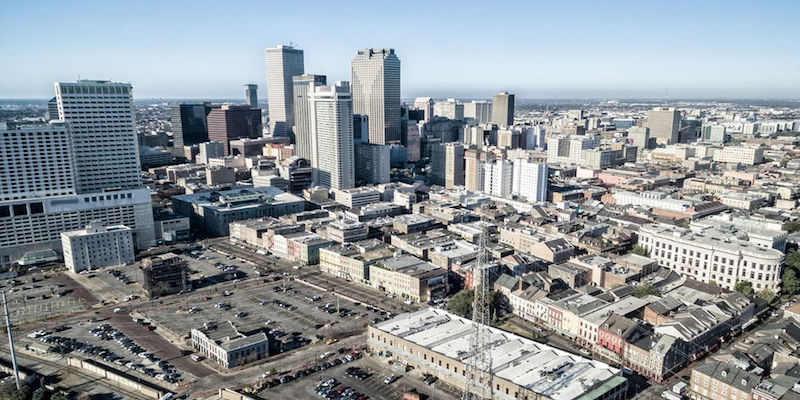The biggest change affecting the flood insurance rates for New Orleans homeowners went into effect in 2016, when FEMA introduced new flood maps after a $14.5 billion post-Katrina upgrade to the city’s flood protection and drainage systems.
What do you need to know about floodplain management ordinances? What affects flood insurance rates? And do you need to carry a policy — even if you’re buying property in a low-risk zone?
Despite two strong hurricanes wreaking havoc in the Southern states last year alone, New Orleans saw a 3.8-percent drop in flood insurance policies. According to FEMA, which manages the National Flood Insurance Program (NFIP), more than 3,200 residential and commercial flood insurance policies dropped or lapsed between June 2016 and June 2017. Interestingly, the state of Louisiana overall saw an 8.6-percent upswing during the same time period — which many contribute to several major floods in the past two years.
So, what factors contribute to the decline in New Orleans flood insurance policyholders? And why do government officials, real estate companies, and flood-protection experts all agree that flood insurance is a good idea, even if you’re buying in a lower-risk flood zone?
The Flood Map Overhaul of 2016
Perhaps the biggest change affecting the flood insurance rates in New Orleans went into effect in September 2016, when the government introduced new flood maps after a $14.5 billion post-Katrina upgrade to the city’s flood protection and drainage systems. This meant lower insurance rates for about 53 percent of all the properties in the city that were placed in a lower-risk, so-called “X” zone and out of the so-called Special Flood Hazard Areas (and estimated 3 percent of properties ended up in the higher-risk zones on the new maps). The homeowners whose properties were mapped into a lower-risk flood zone are no longer required by their mortgage companies to carry flood insurance.
The move out of the flood hazard area meant significant savings for homeowners. For example, with the average cost of a flood insurance policy being $961 in 2016, this meant that the $250,000 property would cost about $500 less to insure annually. Some NFIP provisions also allowed homeowners in Special Flood Hazard Areas to be grandfathered in with lower rates, locking in the rate at least temporarily.
What Else Affects Your Flood Insurance in New Orleans?
NFIP, which was set to expire late last year and was extended at least three times — the last time being through July of this year — is in serious debt. There was a $25 million deficit before Harvey and Irma, and the balance keeps rising. Both the impending expiration and the debt might leave almost 500,000 flood insurance policy holders of Louisiana in the lurch.
Congress has also been unable to agree upon the proposed provision to end the grandfathering of lower premiums for properties after a second claim is filed, nor on a standard program renewal cycle (five-, six-, and 10-year extensions were proposed but none were approved).
How Are the Rates Determined?
The rates mainly depend on the property’s location, elevation, and flooding history. Your flood insurance agent will rate your policy using the 2016 Flood Insurance Rate Maps provided by the city as part of its Floodplain Management resources. This community program includes “requirements for zoning, subdivision or building, and special-purpose floodplain ordinances.”
Flood insurance is available for both the structure and contents, and takes a month to go into effect. According to city officials, a single-family home in New Orleans can be insured up to $250,000. All city floodplain development must meet the flood protection requirements, too, and requires a permit.
Are You in the Flood Zone?
Contact one of our real estate agents or an insurance agent to determine whether you’re in the high-risk zone. You can also look up the address using FEMA’s Map Service Center or the city’s maps (like the Orleans Parish one). That way, you can avoid certain zones in your search if you’re looking for a home to buy, or, similarly, target lower-risk areas only.
Do You Need Flood Insurance?
As many real estate professionals and flood protection experts will tell you, there’s no such thing as a no-flood zone in New Orleans. And as the residents of places like New Orleans, Laplace, and Baton Rouge — whose homes have flooded in the past two years in the areas that typically didn’t flood — will attest, the risk of flooding is ever-present, and never fully eliminated.
That’s why city, state, and federal government officials continuously stress the importance of having flood insurance — even if owners are located in a lower-risk zone. The New Orleans Advocate summarized it nicely, when quoting the then-Mayor Mitch Landrieu as saying, back in 2016, “Whether you live in a flood zone or not, you should continue to buy flood insurance. We don’t want to be penny-wise and pound-foolish.”
